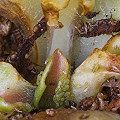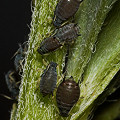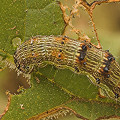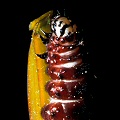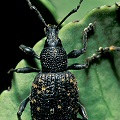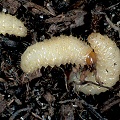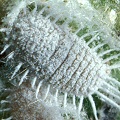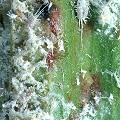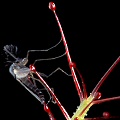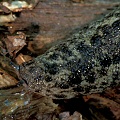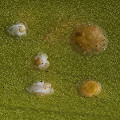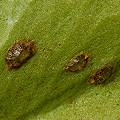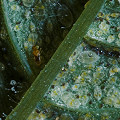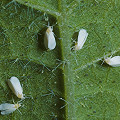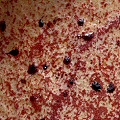Q: What is this bug eating my carnivorous plants?
A: Even though carnivorous plants eat insects, they are still victimized by pests. Some
pests are harder to
treat than others. Before you can attack the creature attacking your plant,
you must identify the pest. I hope
this gallery of insect villains and pathogens,
including descriptions, photographs, and links, will aid you in your
quest for a pest free growing arrangement.
Treatments for these pests are discussed on the next FAQ page.
Aphids This insect lives by sucking the juices of plants. You may find
them in herds, feasting on your
beloved plants. Aphids have few defenses against enemies other than the
ability to reproduce at astonishing rates (females are supposedly born pregnant,
although who the "father" is in this case baffles me). In the wild, plants infested with aphids usually
become discovered by natural predators and so rarely become problems. But in cultivated situations such
predators are rare. Ants enjoy feeding upon the sugary solution secreted by aphids, so they will actually
protect aphids from predators---this does not help the carnivorous plant grower one bit. Aphids come
in a variety of colors, and are all about 2.5 mm or smaller.
Major infestations are easy to identify---the herds of aphids are easily seen, and
make the plant produce twisted, abnormal, stunted growth.
Sometimes you will discover the aphid infestation only after the aphids have all
been killed by natural predators or an insecticide application. In this case,
you will still see the deformed leaves, and the plants will have scattered,
dead white aphids on them.
Black vine weevil This insidious monster is not such a problem in
the adult, beetle form, but it is a ravenous consumer of Sarracenia and
Darlingtonia rhizome. If you see the adults on your plants pluck them off
and kill them. The larvae will probably kill your plants. This pest is
usually reported in coastal regions.
Caterpillars These larval butterflies and moths are just as bad as snails
and slugs. If you find chewed holes in your plants and little black poops,
you know that Mr. Caterpillar has been visiting. The best thing to do when
you have these is just find as many of them as you can and remove them manually.
They are usually fairly easy to find, once you realize you have them. They
can, however, have quite sneaky camouflage, so you may have to look carefully.
Fungus gnats
This is an insect you do not have to worry about. Fungus gnats are little
brown insects which race about the soil surface. It is possible that the larvae might eat seedling plants,
but this is not certain. I do not mind fungus gnats especially since they make marvelous food for
Pinguicula and pygmy sundews!
Mealy bugs This insect is closely related to scale, but instead of producing a hard shell it produces
a waxy powdery coating (which protects it from most pesticides). If I did not despise these creatures so
much, I might find their complicated, lacy outlines pretty. Damn little monsters.
Unlike aphids and scale,
mealy bugs crawl about a great deal, so they can relocate to many parts of your collection. They also infect roots,
so a plant which looks like it has only one or two mealy bugs may actually be supporting a mighty
mealy bug-civilization just below the soil surface! Major infestations look like white, cottony masses.
Individual mealy bugs are a few millimeters long, but I have seen some desert species which were
nearly 1 cm in size!
Powdery mildew This pest is a fungus that looks like a white
powdery dusting on the surface of the leaves. It is particularly bad for
Cephalotus plants.
Scale This is a strange beast which does not look much like a live creature. When female scale
are very young they attach to a plant, develop a hard coating, and remain
stationary forever after. Her hard, waxy coating makes her impervious to many
pesticides. Very bad
infestations look like countless circular or elliptical brown discs on your plant about as large as a letter "O"
in normal 12pt type (like in most books). Sometimes they are flat, other times they bulge outwards. They
come in various colors. Mind you, the scale most people know are all the female individuals---male
scale insects are rarely seen.
Snails and Slugs These creatures are well known to us all, and they love to seek young
plant tissue and devour it with their nasty rasping teeth. Grind, grind, grind, and soon your
Sarracenia pitchers are destroyed!
Sooty Molds This problem is caused by several Actinomyces
fungi from the order Dothideales, including the genera Capnodia
(Fumago) and Limacinia. Sooty mold
is actually more of a symptom of a sick plant than it is a genuine
problem. It grows because pests such as mealy bugs, scale, or aphids
exude sugary substances which supports the sooty mold. Sooty mold may
also be an annoying problem in pest-free conditions when the plants are
producing sugars from pitchers (in order to attract prey). It usually
washes off under a spray of water. It may take some light scrubbing to
remove it from Nepenthes or Sarracenia pitchers.
Spider Mites I have never seen these on carnivorous plants in any quantity except
when they once attacked some of my Venus flytraps and also a Cephalotus. The results were
saddening. Spider mites are tiny specks which usually set up shop at the growth tip of plants. There they
form large colonies. You can identify them because they make large webby masses, much like spider webs.
You can distinguish them from a spider web
(which would be nothing to worry about) by 1)the position near the growth
tip of the plant 2)the presence of mites on the webs---look for tiny red specks moving about and 3)the
absence of a spider.
Thrips These are tiny insects that are very difficult to see---you need a microscope to see their
elongated bodies. But symptoms of their attack are unmistakable. When they suck the juices from a plant
they exude a black blob on their bums, just like aphids do. These droplets
drop off, and one of the first signs of thrips on your plants may be the
presence of these tiny black tarry spots on your plants. As the infestation
advances, the host plant will become discolored---if it was once a lovely rich green, it will appear whitish,
almost like it was somehow becoming bleached. The tissue may seem dryish, or crisped. I hate thrips.
Oh, another thing, never say "thrip." The creature is called thrips. For example, practice saying the
following phrase, "I saw a thrips under a microscope and boy, was it ugly!"
Whitefly These tiny flying insects (only about 1.5 mm long)
are similar in basic appearance to fungus gnats (see above),
but unlike those insects can be a serious problem in greenhouses. Fortunately I have never seen them
attack carnivorous plants in significant quantity.
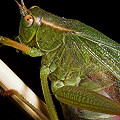
Katydid
Worms Most gardeners will tell you that worms are your friend. But that is because worms
eat dirt and pass it through their gut, excrete the processed dirt, and thereby enrich the nutrient
content of the soil by turning inert organic matter into a loam that plants can use. But since
carnivorous plants require soil low in nutrients, worms function to degrade the soil for them by making
it too rich. I have problems with red worms in particular. I hate 'em!
Various chewing insects Occasionally your plants will be attacked by miscellaneous chewing pests such as katydids,
grasshoppers, etc. This is somewhat uncommon, but devastating when it occurs.
Page citations: Rice, B.A. 2006a; personal observation.
